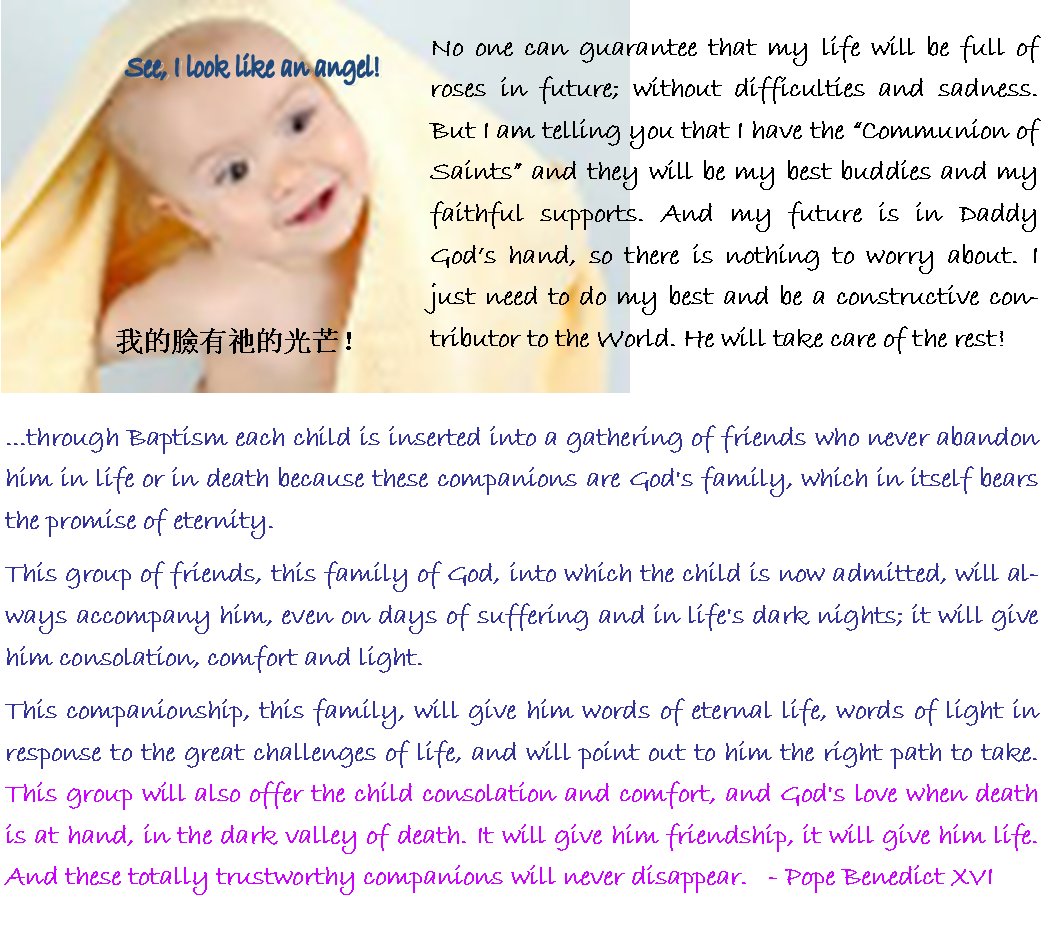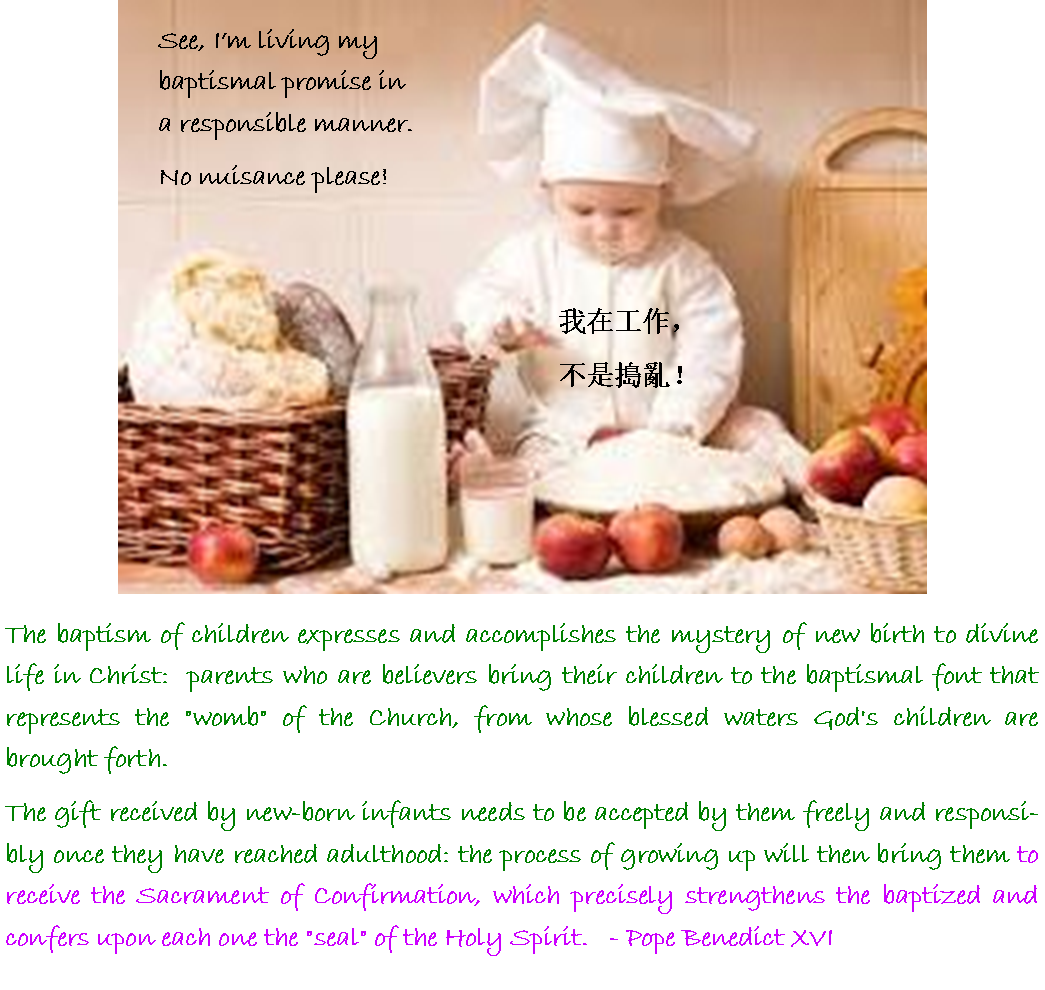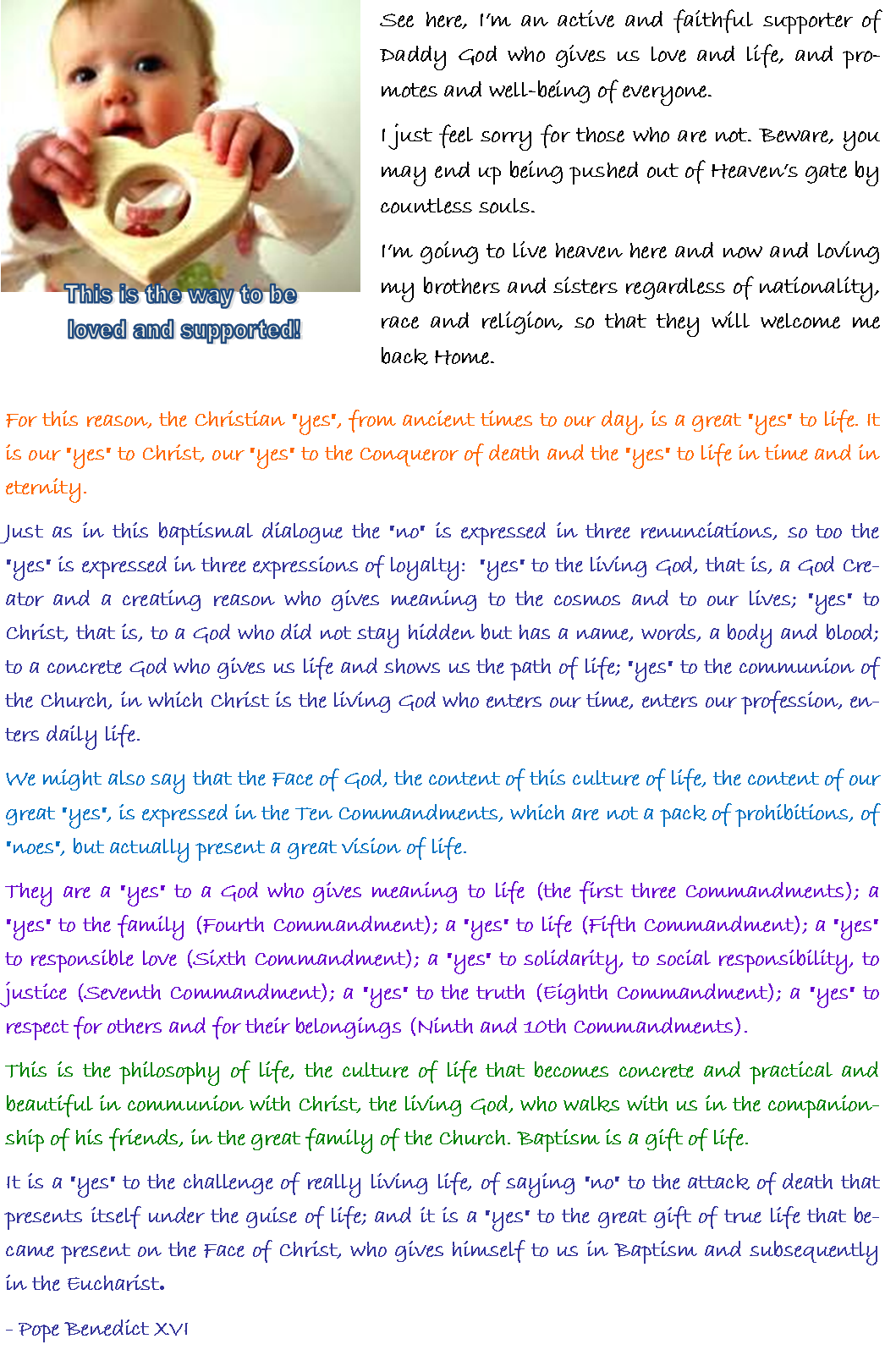|
†325 |

|
Yes, Baptism inserts us into communion with Christ and therefore gives life, life itself. We have thus interpreted the first dialogue we had with him here at the entrance to the Sistine Chapel. Now, after the blessing of the water, a second dialogue of great importance will follow. This is its content: Baptism, as we have seen, is a gift; the gift of life. But a gift must be accepted, it must be lived.
A gift of friendship implies a "yes" to the friend and a "no" to all that is incompatible with this friendship, to all that is incompatible with the life of God's family, with true life in Christ.
Consequently, in this second dialogue, three "noes" and three "yeses" are spoken. We say "no" and renounce temptation, sin and the devil. We know these things well but perhaps, precisely because we have heard them too often, the words may not mean much to us.
If this is the case, we must think a little more deeply about the content of these "noes". What are we saying "no" to? This is the only way to understand what we want to say "yes" to.
In the ancient Church these "noes" were summed up in a phrase that was easy to understand for the people of that time: they renounced, they said, the "pompa diabuli", that is, the promise of life in abundance, of that apparent life that seemed to come from the pagan world, from its permissiveness, from its way of living as one pleased.
It was therefore "no" to a culture of what seemed to be an abundance of life, to what in fact was an "anti-culture" of death. It was "no" to those spectacles in which death, cruelty and violence had become an entertainment.
Let us remember what was organized at the Colosseum or here, in Nero's gardens, where people were set on fire like living torches. Cruelty and violence had become a form of amusement, a true perversion of joy, of the true meaning of life.
This "pompa diabuli", this "anti-culture" of death was a corruption of joy, it was love of deceit and fraud and the abuse of the body as a commodity and a trade.
It is an "anti-culture" manifested, for example, in drugs, in the flight from reality to what is illusory, to a false happiness expressed in deceit, fraud, injustice and contempt for others, for solidarity, and for responsibility for the poor and the suffering; it is expressed in a sexuality that becomes sheer irresponsible enjoyment, that makes the human person into a "thing", so to speak, no longer considered a person who deserves personal love which requires fidelity, but who becomes a commodity, a mere object.
Let us say "no" to this promise of apparent happiness, to this "pompa" of what may seem to be life but is in fact merely an instrument of death, and to this "anticulture", in order to cultivate instead the culture of life. For this reason, the Christian "yes", from ancient times to our day, is a great "yes" to life. It is our "yes" to Christ, our "yes" to the Conqueror of death and the "yes" to life in time and in eternity. |
|
Just as in this baptismal dialogue the "no" is expressed in three renunciations, so too the "yes" is expressed in three expressions of loyalty: "yes" to the living God, that is, a God Creator and a creating reason who gives meaning to the cosmos and to our lives; "yes" to Christ, that is, to a God who did not stay hidden but has a name, words, a body and blood; to a concrete God who gives us life and shows us the path of life; "yes" to the communion of the Church, in which Christ is the living God who enters our time, enters our profession, enters daily life.
We might also say that the Face of God, the content of this culture of life, the content of our great "yes", is expressed in the Ten Commandments, which are not a pack of prohibitions, of "noes", but actually present a great vision of life.
They are a "yes" to a God who gives meaning to life (the first three Commandments); a "yes" to the family (Fourth Commandment); a "yes" to life (Fifth Commandment); a "yes" to responsible love (Sixth Commandment); a "yes" to solidarity, to social responsibility, to justice (Seventh Commandment); a "yes" to the truth (Eighth Commandment); a "yes" to respect for others and for their belongings (Ninth and 10th Commandments).
This is the philosophy of life, the culture of life that becomes concrete and practical and beautiful in communion with Christ, the living God, who walks with us in the companionship of his friends, in the great family of the Church. Baptism is a gift of life.
It is a "yes" to the challenge of really living life, of saying "no" to the attack of death that presents itself under the guise of life; and it is a "yes" to the great gift of true life that became present on the Face of Christ, who gives himself to us in Baptism and subsequently in the Eucharist.
I said this as a brief comment on the words in the baptismal dialogue that interpret what happens in this Sacrament. In addition to the words, we have gestures and symbols, but I will just point them out very briefly.
We have already made the first gesture: it is the Sign of the Cross, which is given to us as a shield that must protect this child in his life; and as an "indicator" that points out the way of life, for the Cross sums up Jesus' life.
Then, there are the elements: water, the anointing with oil, the white garment and the flame of the candle.
Water is the symbol of life: Baptism is new life in Christ. The oil is the symbol of strength, health and beauty, for it truly is beautiful to live in communion with Christ. Then, there is the white garment, as an expression of the culture of beauty, of the culture of life. And lastly, the flame of the candle is an expression of the truth that shines out in the darkness of history and points out to us who we are, where we come from and where we must go.
Dear Godparents, dear parents, dear brothers and sisters, let us thank the Lord today, for God does not hide behind clouds of impenetrable mystery but, as today's Gospel said, has opened the heavens, he has shown himself, he talks to us and is with us; he lives with us and guides us in our lives.
Let us thank the Lord for this gift and pray for our children, so that they may truly have life: authentic, eternal life. Amen. |

|
BENEDICT XVI ANGELUS Feast of the Baptism of the Lord
Dear Brothers and Sisters,
On this Sunday after the Solemnity of the Epiphany, we are celebrating the Feast of the Baptism of the Lord, which ends the liturgical season of Christmas. Today, we fix our gaze on Jesus, who was baptized at the age of about 30 by John in the Jordan River.
It was a baptism of penance that used the symbol of water to express the purification of the heart and of life. John, known as the "Baptist", that is, the "Baptizer", preached this baptism to Israel in preparation for the imminent coming of the Messiah; and John the Baptist told everyone that someone else would come after him, greater than he, who would not baptize with water but with the Holy Spirit (cf. Mark 1: 7-8).
And so it was when Jesus was baptized in the Jordan, the Holy Spirit came down and settled upon him like a dove, and John the Baptist recognized that he was Christ, the "Lamb of God" who had come to take away the sins of the world (cf. John 1: 29).
Therefore, the Baptism in the Jordan is also an "epiphany", a manifestation of the Lord's Messianic identity and of his redeeming work, which will culminate in another "baptism", that of his death and Resurrection, for which the whole world will be purified in the fire of divine mercy (cf. Luke 12: 49-50).
On this Feast, John Paul II used to administer the Sacrament of Baptism to various children. This morning, for the first time, I too have had the joy of baptizing 10 new-born babies. I renew with affection my greeting to these little ones and their families, as well as to their Godparents.
The baptism of children expresses and accomplishes the mystery of new birth to divine life in Christ: parents who are believers bring their children to the baptismal font that represents the "womb" of the Church, from whose blessed waters God's children are brought forth.
The gift received by new-born infants needs to be accepted by them freely and responsibly once they have reached adulthood: the process of growing up will then bring them to receive the Sacrament of Confirmation, which precisely strengthens the baptized and confers upon each one the "seal" of the Holy Spirit.
Dear brothers and sisters, may today's solemnity be a favourable opportunity for all Christians to rediscover with joy the beauty of their own Baptism, which is an ever-timely reality if it is lived with faith: it ceaselessly renews within us the image of the new person, in holiness of thought and action.
May the Virgin Mary obtain for us an ever-deeper understanding of the value of our Baptism and of witness to it by leading a dignified life.
------------------------------------------------------------------
After the Angelus:
I greet all the English-speaking visitors present at this Angelus. Today's celebration of the Baptism of Our Lord is a joyful reminder of the gift of our own Baptism! Grateful for the new life given to us in this Sacrament, may Christians always bear witness in the world to the values and truths of God's Kingdom!
I wish you all a good Sunday!
Previous†††††††††††††† Next†††††††††††††† Back†††††††††††††† Home
15 February 2015 |
